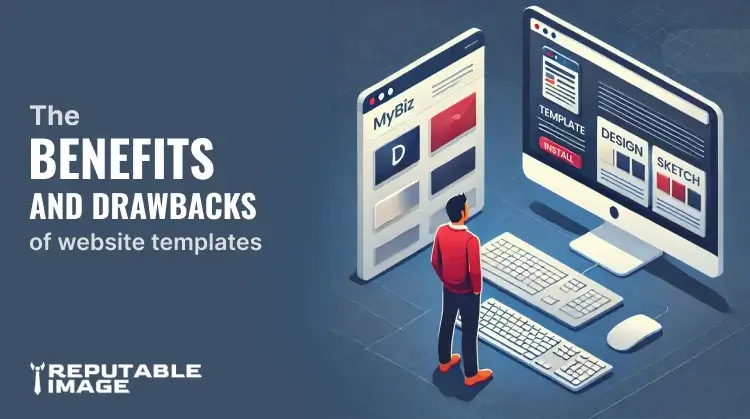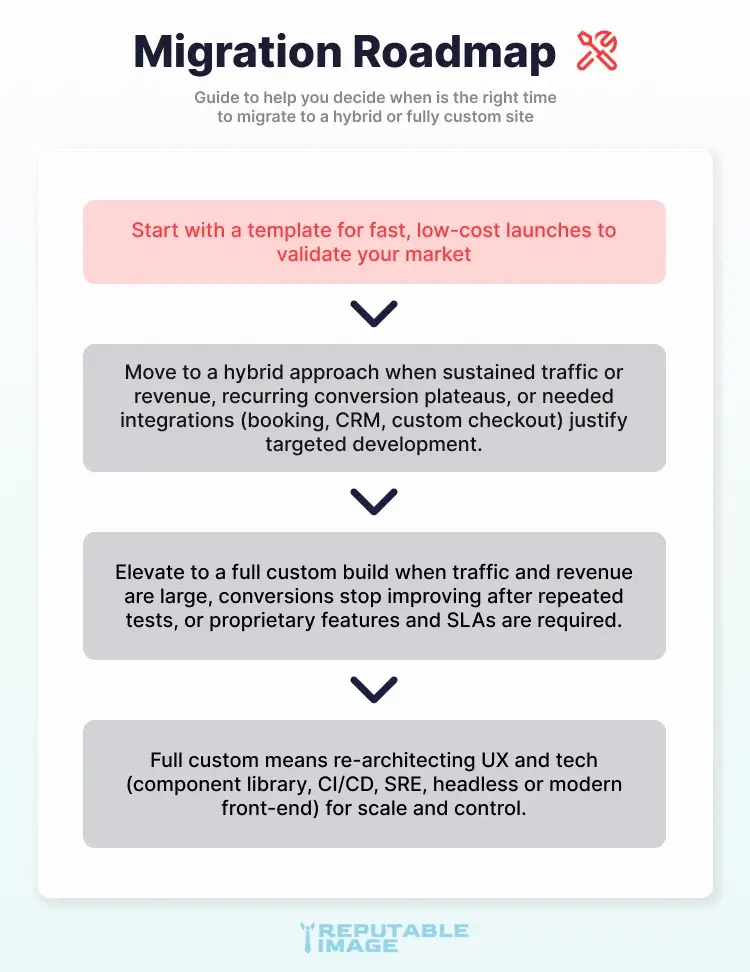
The Benefits and Drawbacks
of Website Templates
The benefits and drawbacks of website templates matter for every small business deciding between speed and long-term control. Templates can get you online quickly at low cost, but they come with tradeoffs in uniqueness, flexibility, and sometimes performance. This article walks through practical pros and cons, typical pain points templates solve (and create), and how to choose the right path for your business.
Why Templates are Attractive to Small Businesses
A template gets you live fast. For many small operations—local shops, consultants, or makers—templates provide a complete layout, placeholder copy, and built-in components (contact forms, galleries, commerce) so you can publish in days, not weeks. That speed and low upfront cost are the most obvious benefits. (web.dev.co)
Templates also reduce technical friction. Most templated systems include documentation, community support, and frequent updates from theme marketplaces, which helps owners handle maintenance without hiring a developer. That makes templates an appealing choice for teams with limited budgets.
Benefit:
Cost and Speed (Real Savings)
Templates drastically lower the initial cost of a website. Instead of paying for custom design, branding exploration, and development, you can buy or use a free theme and configure it yourself. For businesses that need a web presence quickly—seasonal promotions, pop-up shops, or early-stage ventures—this is often the correct tradeoff.
Because templates are pre-built, they shorten time-to-market and make iterative changes easier; you can focus on content and offers rather than layout engineering. This advantage improves short-term cashflow and reduces opportunity cost for founders.
Benefit:
Built-in Patterns and Tested UI
Good templates are created from common UX patterns—hero areas, service blocks, and CTA placement that have been battle-tested across many sites. That means less UX guesswork: the template likely already includes best-practice page structures. If you pair a good template with focused copy and images, you can get professional results quickly. (Host Papa)
If you pair a good template with focused copy and images, you can get professional results quickly. Read Copywriting Strategies for Small Business Websites.
Drawback:
Limited Uniqueness and Branding Friction
Templates are not magic brand-makers. Even a heavily customized theme can feel “templated” if the underlying layout and structure remain obvious. For businesses that rely on distinct brand identity—creative agencies, premium boutiques, or enterprises—templates can constrain storytelling and differentiation. Making a template wholly unique often requires developer time that narrows the initial cost advantage.
Drawback:
Feature and Integration Limits
Templates are built for general cases, not every niche integration. If your business needs a custom booking flow, complex product configurator, or unusual CRM connection, the template may need significant workarounds or custom development. Those add-on costs can convert a cheap template into an expensive long-term project.
Drawback:
Performance & Bloat (Real-World Impact)
Some templates include many features and plugins to appeal to a broad audience. That can add scripts, styles, and assets you don’t need—slowing pages and hurting SEO. Unless you actively audit and strip unused features, a template can introduce performance problems that reduce conversions. Regular performance checks and selective optimization are essential when using templates. (web.dev.co)
Drawback:
Update & Maintenance Risk
If you rely on third-party templates and plugins, updates can break things unexpectedly—especially when multiple components interact. While templates reduce upfront build time, they can increase maintenance complexity when updates collide. Use staging sites for updates and have a rollback plan to reduce risk.
When Templates Make Sense (use-cases)
Templates are ideal when:
- You need a low-cost, fast launch.
- Your offering is straightforward and not highly customized.
- You plan to validate a market before investing in a custom site.
- You have limited technical resources and want a structure with community support.
For many small businesses, a template is a perfectly sensible first step—provided they plan for future evolution.
When Custom (or Hybrid) is Better
Custom design pays off when brand differentiation, complex integrations, or performance are strategic advantages. That doesn’t always mean building from scratch; hybrid approaches (a premium template plus targeted custom development) can give the best of both worlds: speed plus unique touches.
If you expect your site to be a primary revenue engine—high traffic e-commerce or lead generation—investing in a custom UX and optimized front-end will likely pay for itself through higher conversion rates and fewer technical constraints. (Kinsta)

Practical Checklist if you Choose a Template
- Pick a reputable marketplace or theme provider with frequent updates and support.
- Use a staging environment for updates and a tested backup strategy.
- Audit unused scripts/styles and remove or disable them to keep performance tight.
- Customize images, fonts, and copy to reduce template recognition and better reflect your brand. Read UI/UX Best Practices for Small Business Websites.
- Document Plugin Versions and Maintain a Simple Update Log.
Improve template appearance with strong visual identity—see A Guide to Effective Logo Design.
Migrating from Template
to Custom (Plan It)
Treat a template as version 1. Define migration triggers up-front: traffic milestones, conversion plateaus, or feature gaps. When migration time comes, export content, map templates to new page designs, and prioritize rebuilds that unblock revenue or reduce support time.

Business Impact:
Long-Term Benefits and the Pain-Point Tradeoffs
Short term: templates save money and speed time-to-market. Long term: they can slow differentiation and create technical debt. The right choice balances near-term needs with a roadmap for growth. When used thoughtfully, templates can be a strategic stepping-stone—if you plan updates, performance audits, and eventual customization.
Conclusion:
When to Call the Pros
Templates are a practical, cost-effective choice for many small businesses—but they’re not a panacea. At Reputable Image, we help teams choose the right path: template adoption with performance & brand polish, hybrid customizations, or full custom builds. We also offer copywriting, hosting, front-end coding, and maintenance plans so your site works hard for your business today and scales cleanly tomorrow.
If you'd like us to look at your existing website to make improvements or we can build a new site for you to improve speed, messaging, SEO, and conversions. If you'd like a FREE site demo, please take a minute to fill out this quick free demo form with only 3-7 fields, so we can customize your demo for your small business.
Sources:
1. Web Dev - "Pros & Cons of Using Website Templates for Web Design"
https://web.dev.co/blog/website-templates
2. Host Papa - "The Pros And Cons Of Using Templates In Website Design"
https://www.hostpapa.com/blog/web-design-development/the-pros-and-cons-of-using-templates-in-website-design
3. IT Pro - "WordPress.com vs WordPress.org: Which Is Better for Your Website?"
https://kinsta.com/blog/wordpress-com-vs-wordpress-org


